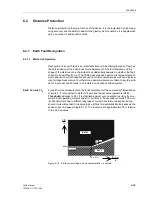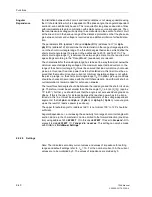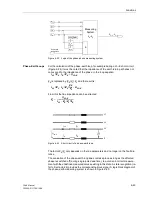
Functions
6-40
7SA6 Manual
C53000-G1176-C156-2
Angular
Dependence
If a distinction between short circuit and load conditions is not always possible using
the U/I characteristic which is independent of the phase angle, the angular dependent
section d-e can additionally be used. This is required for long lines and section of lines
with intermediate infeed in combination with small source source impedances. Then
the local measured voltage will only drop to a small extent in the event of a short circuit
at the line end or in the back-up range of the distance protection so that the phase an-
gle between current and voltage is required as an additional criterion for fault detec-
tion.
The parameters
I
ϕ
>
(address
1616
) and
Uphe(I
ϕ
>)
(address
1617
) or
Uph-
ph(I
ϕ
>)
(address
1618
) determine the characteristic in the range of large angles
ϕ
K
,
i.e. in the short-circuit angle range. The threshold angles themselves, which define the
short-circuit angle range
ϕ
K
, are set in the addresses
1620
ϕ
>
and
1621
ϕ
<
. The
short-circuit angle range
ϕ
K
is between these two angles. Here too, the required volt-
age settings according to the “Pickup Mode” (see above) are relevant.
The characteristic for the load angle range has to be set in a way that is just below the
minimum expected operating voltage at the maximum expected load current. In the
range of the short circuit angle
ϕ
K
it must be ensured that load current may not cause
pick-up in this area. If reactive power has to be tranferred via this line it must be en-
sured that the maximum reactive current at minimum operating voltage is not within
the pick-up range, i.e. the short-circuit angle range
ϕ
K
. If in doubt, pick-up conditions
should be checked in accordance with the U/I/
ϕ
characteristic. An arithmetic short-cir-
cuit calculation is recommended for extensive networks.
The lower threshold angle should be between the load angle and the short-circuit an-
gle. Therefore, it must be set smaller than the line angle
ϕ
L
= arctan (X
L
/R
L
) (approx.
10° to 20°). Further, you should check that the angle is not exceeded during load con-
ditions. If this is the case, for instance because the reactive power has to be trans-
ferred via this line, it must be ensured that the parameters of the voltage-dependent
segment d, that is
Iphi>
and
Uph-e (Iphi>)
or
Uph-ph (Iphi>)
rule out a pick-
up as the result of reactive power (see above).
The upper threshold angle
ϕ
<
(address
1621
) is not critical. 100° to 120° should be
sufficient.
Angular dependence, i.e. increasing the sensitivity for a large short-circuit angle with
section d and e in the characteristic, can be limited to the forward direction (line direc-
tion) using address
1619
EFFECT
ϕ
. In this case
EFFECT
ϕ
is set to
Forward.
Oth-
erwise it remains
EFFECT
ϕ
=
forward & reverse
. This setting can only be made
with DIGSI
®
4 “Additional Settings“.
6.2.2.5
Settings
Note:
The indicated secondary current values and values of impedance for setting
ranges and default settings refer to I
N
= 1 A. For the nominal current 5 A the current
values are to be multiplied by 5. The values of impedance are divided by 5.
Summary of Contents for siprotec 7SA6
Page 2: ...Siemens Aktiengesellschaft Book No C53000 G1176 C156 2 ...
Page 18: ...xviii 7SA6 Manual C53000 G1176 C156 2 ...
Page 32: ...Introduction 1 14 7SA6 Manual C53000 G1176 C156 2 ...
Page 82: ...Hardware and Connections 2 50 7SA6 Manual C53000 G1176 C156 2 ...
Page 119: ...SIPROTEC 4 Devices 4 25 7SA6 Manual C53000 G1176 C156 2 Figure 4 20 CFC Logic example ...
Page 190: ...Configuration 5 62 7SA6 Manual C53000 G1176 C156 2 ...
Page 652: ...Installation and Commissioning 8 78 7SA6 Manual C53000 G1176 C156 2 ...
Page 724: ...Technical Data 10 56 7SA6 Manual C53000 G1176 C156 ...
Page 800: ...Appendix A 76 7SA6 Manual C53000 G1176 C156 2 ...
Page 866: ...Appendix B 66 7SA6 Manual C53000 G1176 C156 2 ...
















































